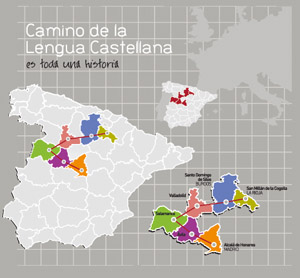


The “Camino de la Lengua Castellana” (Route of the Castilian Language) is an itinerary based around the history of the Castilian (Spanish) language and passes through places which were important in its origins, development and expansion. These places are San Millán de la Cogolla (La Rioja), Santo Domingo de Silos (Burgos), Valladolid, Salamanca, Ávila and Alcalá de Henares (Madrid), four of which are World Heritage Sites..
 Some of the most important caracteristics os these places are: San Millán de la Cogolla (La Rioja), for its importance as the roots of Castilian Spanish in its marginal notes, the Glosas Emilianenses; Santo Domingo de Silos (Burgos), for the important documents which were written there, such as the Glosas Silenses; Valladolid, which would have great importance when Spanish reached America (the New World); Salamanca, for the importance of its university, the oldest in Spain, and because it is where the first Spanish Grammar was written; Ávila, the city was important for the presence there of Saint Teresa de Jesús and Saint Juan de la Cruz, two key writers in mystic literature; and Alcalá de Henares (Madrid), for its historic university and for being the birthplace of Cervantes, author of Don Quijote de La Mancha and because it is where the King and Queen of Spain present the most important literary prize in Spain each year, the “Premio Cervantes”. What is more, four of these six places have been declared World Heritage Sites by UNESCO (San Millán, Salamanca, Ávila and Alcalá)
Some of the most important caracteristics os these places are: San Millán de la Cogolla (La Rioja), for its importance as the roots of Castilian Spanish in its marginal notes, the Glosas Emilianenses; Santo Domingo de Silos (Burgos), for the important documents which were written there, such as the Glosas Silenses; Valladolid, which would have great importance when Spanish reached America (the New World); Salamanca, for the importance of its university, the oldest in Spain, and because it is where the first Spanish Grammar was written; Ávila, the city was important for the presence there of Saint Teresa de Jesús and Saint Juan de la Cruz, two key writers in mystic literature; and Alcalá de Henares (Madrid), for its historic university and for being the birthplace of Cervantes, author of Don Quijote de La Mancha and because it is where the King and Queen of Spain present the most important literary prize in Spain each year, the “Premio Cervantes”. What is more, four of these six places have been declared World Heritage Sites by UNESCO (San Millán, Salamanca, Ávila and Alcalá)
In this itinerary, monuments, writers, squares, cloisters, palaces, libraries, landscapes, tradition and gastronomy are all intermingled, in an open invitation to discover the beauty of these six localities.
The entire tour encourages visitors to discover and experience for themselves all the charm of a history and a language which have evolved in parallel and which are clearly evident in every little spot along the way.
The history of Castilian is not only limited to Spain, it also has an important link with other countries where the Jews emigrated when they left Spain in the 15th century. These are the so-called Sephardic Jews and they have kept the language alive for many years in the places where they settled. These places in the Mediterranean are Jerusalem (Israel), Istanbul (Turkey), Salonika (Greece), Sophia (Bulgaria) and Tetuán (Morocco).